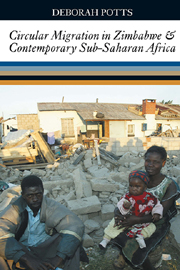Book contents
- Frontmatter
- Contents
- List of Maps, Figures, Tables, Boxes & Photographs
- List of Abbreviations
- Preface
- 1 Introduction
- 2 Regional Paradigms & Approaches to Circular Migration
- 3 Regional Paradigms & Approaches to Circular Migration
- 4 Harare & Zimbabwe
- 5 Migrant Livelihoods & Migration Trajectories in Harare
- 6 Harare Migrants' Rural Links & Assets
- 7 Variations in Migrants' Experience, Perceptions & Options
- 8 Social & CulturalAttachments to Rural Settings & Homes
- 9 Attacking the Urban Poor & Abusing Rural Links Operation Murambatsvina 2005
- 10 Conclusion
- Appendix: Consumer Price Index (all items) for Urban Families 1973–2007
- Bibliography
- Index
9 - Attacking the Urban Poor & Abusing Rural Links Operation Murambatsvina 2005
Published online by Cambridge University Press: 05 July 2013
- Frontmatter
- Contents
- List of Maps, Figures, Tables, Boxes & Photographs
- List of Abbreviations
- Preface
- 1 Introduction
- 2 Regional Paradigms & Approaches to Circular Migration
- 3 Regional Paradigms & Approaches to Circular Migration
- 4 Harare & Zimbabwe
- 5 Migrant Livelihoods & Migration Trajectories in Harare
- 6 Harare Migrants' Rural Links & Assets
- 7 Variations in Migrants' Experience, Perceptions & Options
- 8 Social & CulturalAttachments to Rural Settings & Homes
- 9 Attacking the Urban Poor & Abusing Rural Links Operation Murambatsvina 2005
- 10 Conclusion
- Appendix: Consumer Price Index (all items) for Urban Families 1973–2007
- Bibliography
- Index
Summary
The acceleration in Zimbabwe's economic decline that set in after 2000 was triggered by various political events (see Chapter 4) which attracted much international attention because these set in train the occupation and expropriation of most of the country's formerly white-owned commercial farming land. The most immediate victims of the new ‘fast-track’ land reform programme were the hundreds of thousands of commercial farmworkers whose livelihoods were disrupted or destroyed, and the farms' owners who were evicted (Sachikonye 2003; Hammar et al. 2003). The urban economy and urban livelihoods also suffered terribly, adding to the setbacks of structural adjustment from 1991 and the budget-inspired economic crisis from 1997. Urban based production and output declined further, including the already much beleaguered manufacturing sector. Effective demand for agricultural inputs, much of which had been domestically produced for decades, fell sharply, which had a negative effect on the urban economy. International aid (except humanitarian aid which became increasingly necessary) and investment swiftly dried up, having already slowed after 1997. Access to loans from international financial institutions disappeared as the government defaulted on its various debts. Inflation soared and almost all effective management of the economy ceased.
- Type
- Chapter
- Information
- Publisher: Boydell & BrewerPrint publication year: 2010

